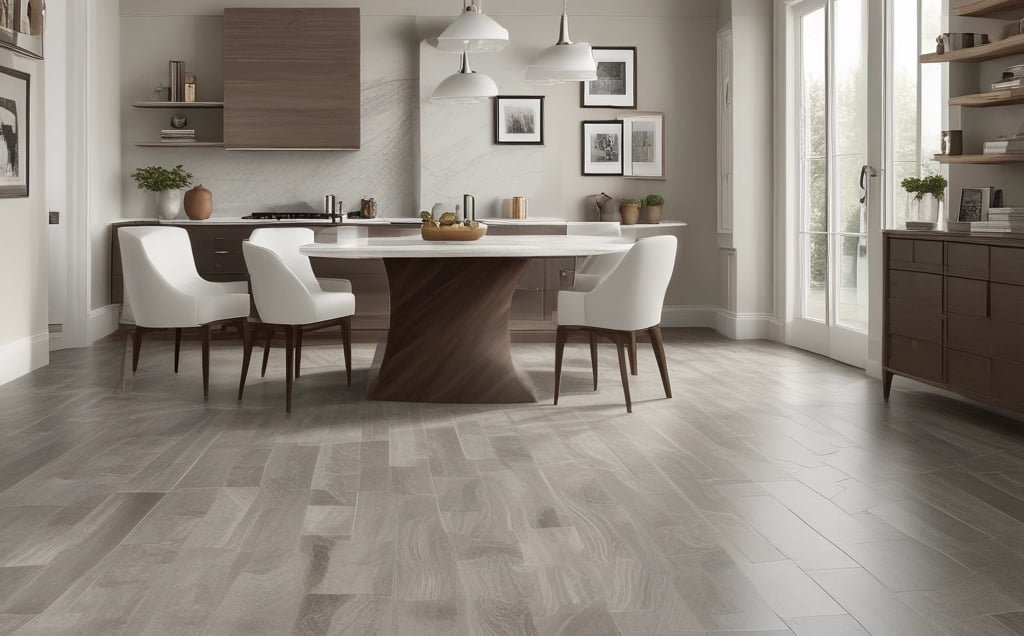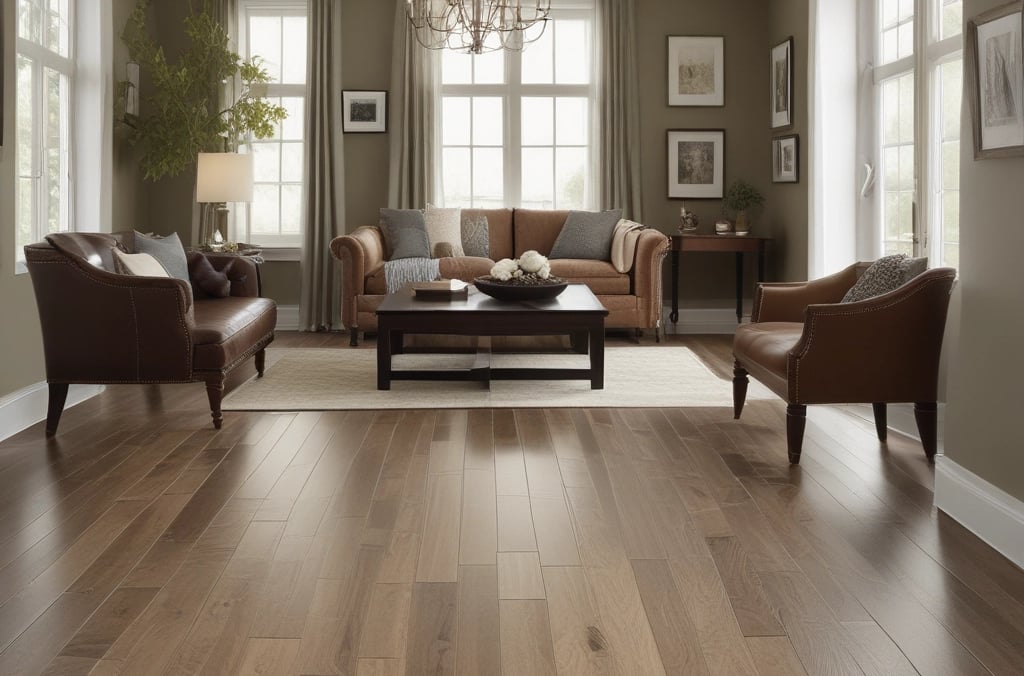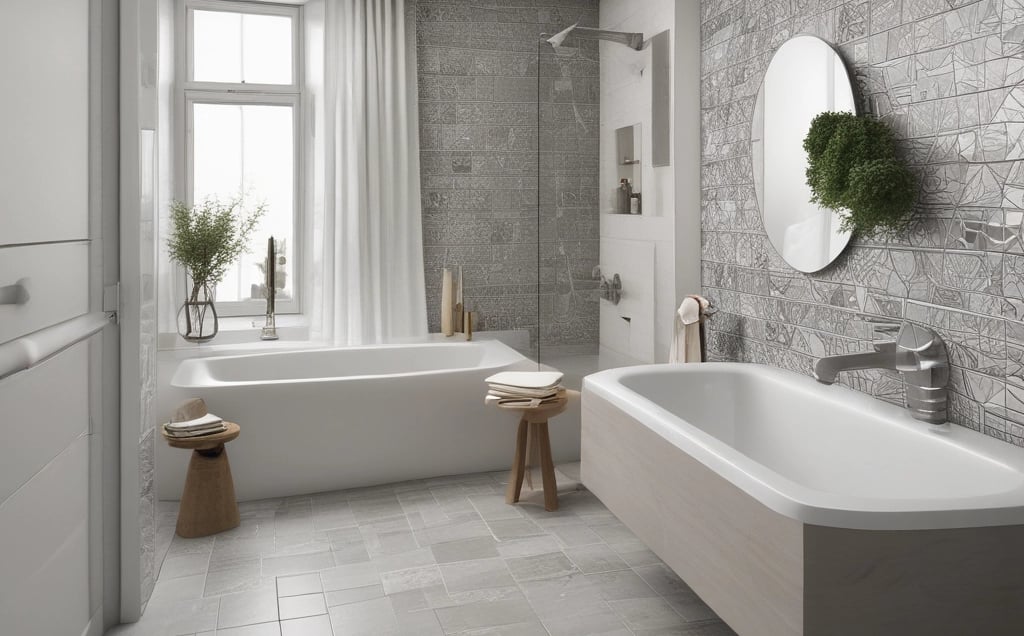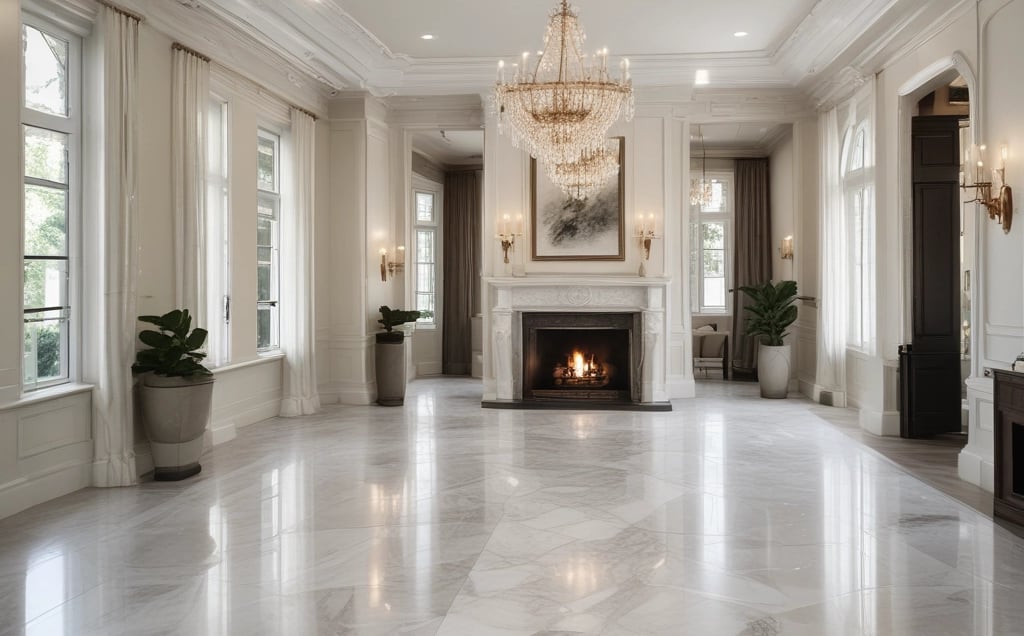Flooring Ideas for House Design: Elevate Your Space
HOME DESIGN IDEAS
Mohamed Amine
10/21/202511 min read


Choosing the Perfect Flooring Material for Every Room
The selection of flooring material is a pivotal aspect of house design, as it influences both aesthetics and functionality. Each room serves a unique purpose, necessitating careful consideration of the flooring that best meets its requirements. Understanding the characteristics of various materials can empower homeowners to make informed decisions that enhance their living spaces.
In high-moisture areas such as bathrooms and kitchens, it is essential to prioritize moisture-resistant options. Materials like porcelain tiles or vinyl are excellent choices due to their water-resistant properties and ease of maintenance. These surfaces not only withstand spills but also come in a range of styles, allowing homeowners to achieve a sought-after look while ensuring functionality.
Conversely, in living rooms and high-traffic spaces, durability is a primary concern. Hardwoods, laminate, and tile floors offer resilience against wear and tear while maintaining an attractive appearance. Notably, hardwood floors can add warmth and elegance, becoming the focal point of the room. Meanwhile, area rugs can enhance comfort and aesthetic appeal without compromising the overall durability of the flooring.
For bedrooms, comfort becomes paramount. Soft flooring options like carpeting or cork provide a warm and inviting atmosphere conducive to relaxation. Carpets are particularly favorable for their sound-absorbing qualities, contributing to a serene environment. Alternatively, luxury vinyl and engineered hardwood can also be considered, as they combine comfort with a sleek design.
In addition to function, considering aesthetic appeal, maintenance, and comfort is essential. Each flooring material offers distinct visual and tactile characteristics that can elevate the overall design of the home. By carefully matching the right flooring with each room's function and style, homeowners can create an environment that is both captivating and functional.
The Role of Flooring in Defining Home Style and Ambiance
Flooring serves as a foundational element in any home design, significantly influencing both style and ambiance. The choice of flooring material, color, and pattern can transform an entire space, reflecting personal tastes and establishing the mood for different areas within a home. For instance, modern flooring styles think sleek hardwood or polished concrete convey a sense of sophistication and minimalism. These materials often complement contemporary furnishings, fostering a fresh and uncluttered vibe.
Conversely, classic flooring options such as traditional parquet wood or elegant marble tiles evoke a sense of timelessness. These styles may incorporate intricate details and a warmth that enhances the grandeur of spaces such as dining rooms or entryways. By choosing classic flooring, homeowners can create an inviting and luxurious atmosphere that is both aesthetically pleasing and practical.
On the other hand, rustic flooring styles, characterized by their natural textures and earthy tones, can induce a cozy and homey feeling. Materials like reclaimed wood or stone tiles add character and warmth to spaces, making them ideal for living areas and kitchens. Such flooring selections not only align with a casual, warm ambiance but also harmonize with a multitude of decor styles, from farmhouse to bohemian.
The interplay between flooring and other design elements such as wall colors, furniture, and lighting further influences how a space feels. Cool-toned flooring can enhance light and airy feelings, while darker hues can create a more intimate and grounded atmosphere. As such, understanding how to effectively integrate flooring choices into the broader spectrum of home design can empower homeowners to create environments that resonate with their personal style and evoke desired moods.
Comparing Hardwood, Laminate, and Vinyl Floors
When considering flooring options for house design, it is essential to evaluate the characteristics of hardwood, laminate, and vinyl floors. Each material presents unique benefits and challenges, influencing the selection process based on factors such as cost, installation time, durability, maintenance, and visual appeal.
Hardwood flooring is a traditional choice, appreciated for its timeless aesthetic and natural beauty. While it can be more expensive, often ranging from $5 to $10 per square foot, its value adds to home equity. The installation process typically takes longer due to the need for professional tools and expertise. Hardwood floors are incredibly durable but can be susceptible to scratching and moisture damage, necessitating regular maintenance, including refinishing every few years. Visually, the range of species, finishes, and colors creates a warmth that many homeowners find appealing.
On the other hand, laminate flooring provides a cost-effective alternative, priced between $1 to $5 per square foot. It is designed to mimic the look of natural wood, making it an attractive option for those on a budget. Installation is generally easier and quicker, as many laminate products feature a floating installation method. In terms of durability, laminate resists scratches and stains better than hardwood; however, it can be less resilient to moisture. Maintenance is minimal, requiring only regular sweeping and occasional damp mopping. Its visual appeal has improved significantly over the years, offering a variety of designs that can suit different styles.
Finally, vinyl flooring serves as a versatile and waterproof option, suitable for high-moisture areas. The cost is comparable to laminate, and the installation process is straightforward, often allowing for DIY approaches. Vinyl is incredibly durable and resistant to scratches and dents, making it an excellent choice for busy households. Maintenance is simple, needing only routine cleaning. A wide range of designs and textures available in vinyl ensures it can effectively enhance the aesthetic of any space.
Choosing between hardwood, laminate, and vinyl involves weighing these factors against personal preferences and lifestyle needs. Understanding the advantages and disadvantages of each option can simplify the decision-making process, allowing homeowners to select the flooring best suited for their environment.
Sustainable and Eco-Friendly Flooring Options
As homeowners increasingly prioritize sustainability in their interior design choices, eco-friendly flooring options have gained significant popularity. One noteworthy material is bamboo, which is classified as a grass rather than a traditional hardwood. Bamboo grows quickly, reaching maturity in just three to five years, making it a renewable resource. It is also durable and resistant to moisture, making it a practical choice for various areas in the home. By opting for bamboo flooring, homeowners can enhance their living spaces while supporting environmentally responsible practices.
Cork is another sustainable flooring option that deserves attention. Harvested from the bark of cork oak trees, this material is renewable and biodegradable. The process of harvesting cork does not harm the tree, allowing it to naturally regenerate over time. Cork also possesses natural insulating properties, contributing to energy efficiency in the home by maintaining a consistent temperature. Furthermore, its unique texture and appearance add visual interest to any room, making it a versatile choice for modern interiors.
Reclaimed wood stands out as an excellent eco-friendly option, as it reduces the demand for new lumber and minimizes waste. Sourced from old barns, warehouses, or other structures, reclaimed wood flooring not only brings character and history to a space but also promotes sustainability. When selecting reclaimed wood, it’s essential to ensure that it has been sourced responsibly, preferably from certified suppliers who follow ethical practices.
For readers looking to incorporate these sustainable materials into their home design, it is crucial to research suppliers thoroughly. Look for certifications such as FSC (Forest Stewardship Council) for wood products, or LEED (Leadership in Energy and Environmental Design) certification for flooring options. These labels ensure that the materials are sustainably sourced and manufactured, aligning with one’s eco-conscious values while enhancing the aesthetic of the home.
How to Match Flooring with Wall Colors and Furniture
Creating a cohesive interior design involves careful consideration of how flooring interacts with wall colors and furniture. Understanding basic color theory can significantly aid in this process. The color wheel provides insights into complimentary, analogous, and triadic color schemes, which can guide homeowners in selecting harmonious flooring options. For instance, pairing neutral wall colors like soft gray or beige with rich hardwood or darker laminate can yield a classic and inviting atmosphere.
Moreover, the choice of flooring material plays a pivotal role in establishing the overall aesthetic. Natural wood floors convey warmth and can be complemented with earthy tones in wall paint and furnishings. Likewise, tile or stone flooring may lend a modern touch, harmonizing well with cooler wall colors like blues or greens. When choosing carpets, opting for textures in muted tones can add depth without overwhelming the space.
Texture and patterns also deserve attention when selecting furnishings and flooring. A room designed with patterned rugs can introduce vibrant hues that work well with both the walls and larger furniture pieces. Conversely, minimalist settings benefit from solid colors in flooring and furniture to maintain a streamlined look. This deliberate interplay helps in achieving visual balance and prevents clashes in design elements.
Examples of successful design combinations can inspire choices think of an open concept living area where light oak flooring meets soft white walls and navy blue accents from furniture pieces. Such combinations can elevate the overall appearance and functionality of a space. When considering flooring options, always keep in mind the existing color palette and the desired mood of the room. Emphasizing synergy between flooring, wall colors, and furniture ensures a refined and inviting living environment.
Modern Tile Designs for Kitchens and Bathrooms
In recent years, modern tile designs have transformed kitchens and bathrooms into sophisticated and functional spaces. The trend towards open-concept living has driven designers to explore an array of styles, sizes, and layouts that cater to diverse tastes and functional requirements. One prominent trend is the use of large-format tiles, which can significantly reduce grout lines and create a sleek and seamless appearance. This type of tile not only enhances visual continuity but also simplifies maintenance, making it an ideal choice for busy households.
Mosaic tiles continue to be popular as well, allowing for intricate patterns and personalized designs. These smaller tiles can be used to create stunning feature walls or backsplashes that serve as focal points in both kitchens and bathrooms. When selecting mosaic tiles, consider versatile materials such as glass, ceramic, or even natural stone to provide texture and depth. The combination of various colors and shapes can also add a playful element to otherwise straightforward spaces.
Textured finishes are another emerging trend, offering both aesthetic appeal and practical benefits. Textured tiles, available in materials like porcelain or cement, can create a tactile surface that not only adds visual interest but also improves slip resistance, making them suitable for wet areas. Additionally, the use of patterned tiles has become increasingly popular, with geometric designs and bold colors making a statement, while softer tones remain a favorite for a more minimalist approach.
When integrating modern tile designs into your kitchen or bathroom, it is crucial to consider the overall layout and functionality. Proper tile arrangement can enhance both the visual flow and usability of these spaces. By thoughtfully selecting and placing tiles, homeowners can effortlessly achieve a contemporary flair that elevates their interiors, ensuring that these essential areas are as stylish as they are practical.
Cozy Comfort: Carpet Flooring Ideas for Bedrooms
When it comes to designing a bedroom, selecting the right flooring is crucial for creating a cozy and inviting environment. Carpet flooring is one of the most popular choices due to its comfort, warmth, and sound insulation properties. Unlike hard surface flooring, carpet provides a soft underfoot experience, making it an excellent option for those who prefer to walk barefoot in their personal space. Moreover, it contributes to better acoustics by absorbing sound, thereby making the bedroom a quieter retreat.
The variety of carpet styles available is vast, catering to diverse tastes and preferences. From plush carpets that offer a luxurious feel to Berber carpets known for their durability, homeowners can choose the type that best fits their desired aesthetic and functional needs. Additionally, carpets come in numerous colors and textures, allowing individuals to customize their bedroom according to their decor themes. Whether opting for a neutral palette to create a serene atmosphere or bold, vibrant hues to make a statement, carpet flooring can enhance the overall design of the room.
Maintenance of carpet flooring is crucial to prolong its lifespan and keep it looking fresh. Regular vacuuming helps remove dust and allergens, making the air quality within the bedroom better. It is also advisable to schedule professional cleanings at least once a year, which can help maintain the carpet's appearance and prevent excessive wear and tear. Furthermore, using area rugs can provide additional protection in high-traffic areas and add layers of comfort and style.
In conclusion, selecting carpet flooring for your bedroom provides numerous benefits that enhance comfort and style. By carefully choosing the appropriate type, color, and texture, and adhering to proper maintenance practices, one can create a warm, cozy sanctuary that invites relaxation and rejuvenation.
Luxury Flooring Inspirations: Marble, Stone, and Parquet
In the realm of upscale interior design, luxury flooring options such as marble, stone, and parquet have emerged as favorites for homeowners seeking to elevate their spaces. These materials not only exude elegance but also offer a unique character that can transform any room into a sophisticated retreat. Marble flooring, with its stunning veining patterns and rich hues, creates an impression of timeless beauty. It is often used in entryways, living rooms, and bathrooms, where its ability to reflect light enhances the openness and grandeur of the space.
Stone flooring, including varieties like granite, slate, and limestone, brings a rugged yet refined appeal. Each stone type boasts distinct textures and colors, providing versatility in design. Stone is particularly popular for outdoor aesthetics, as it withstands the elements while adding a natural, earthy charm. However, its application indoors is equally remarkable, making it an ideal choice for kitchens and hallways. One of the significant advantages of stone flooring is its durability and low maintenance, which ensures longevity in high-traffic areas.
Parquet flooring presents another luxurious option, renowned for its intricate patterns that can be arranged in various designs, such as herringbone or chevron. This style infuses a classic and refined aesthetic into spaces, making it perfect for formal dining rooms or grand entryways. While the installation of parquet can be more complex compared to other types of flooring, its transformative quality and ability to enhance warmth make it an appealing investment. To maintain the beauty of marble, stone, and parquet, regular cleaning and appropriate sealing are essential, allowing the beauty of these exquisite materials to persist for years to come.
Practical Flooring Solutions for High-Traffic Areas
High-traffic areas in a home such as hallways, entryways, and living rooms require flooring solutions that are not only durable but also maintain an aesthetically pleasing appearance. When selecting flooring materials for these frequently used spaces, it's essential to consider options that can withstand the rigors of daily life without compromising on style.
One of the most popular choices for high-traffic flooring is porcelain tile. Porcelain is known for its incredible durability and resistance to scratches, stains, and moisture. Available in a wide array of colors and finishes, porcelain tiles can mimic the look of natural stones or hardwood while providing the added benefit of easy maintenance. Regular sweeping and mopping are typically sufficient to keep these floors looking pristine.
Another excellent option is luxury vinyl flooring, which has gained popularity for its versatility and resilience. Luxury vinyl is constructed to endure heavy foot traffic while offering a warm, inviting look that is ideal for living areas and entryways. It is resistant to dents and scratches, making it an advantageous choice for households with pets or children. Furthermore, luxury vinyl is easier to install and can often be laid over existing flooring, saving time and money on a remodel.
In addition to these materials, hardwood floors, when properly maintained, can also be suitable for high-traffic areas. Choosing a harder wood species such as oak or maple can improve durability. Regular refinishing can restore the surface, ensuring that the wood retains its beauty over time. Applying area rugs in these spaces can also protect the hardwood from wear and provide an additional layer of comfort.
In summary, selecting the right flooring for high-traffic areas is critical for both functionality and aesthetics. Options like porcelain tile, luxury vinyl, and well-maintained hardwood can help enhance the durability and visual appeal of your home's design. Regular maintenance and attention to detail will ensure these areas continue to look great, even with daily use.
References
1.The Flooring Handbook: The Complete Guide to Choosing and Installing Floors
Author: Dennis Jeffries
Link: The Flooring Handbook
2.Wood Flooring: A Complete Guide to Layout, Installation & Finishing
Author: by Charles Peterson
Link: Wood Flooring
3. Flooring 1-2-3
Author: by Larry Johnston
Link: Flooring






